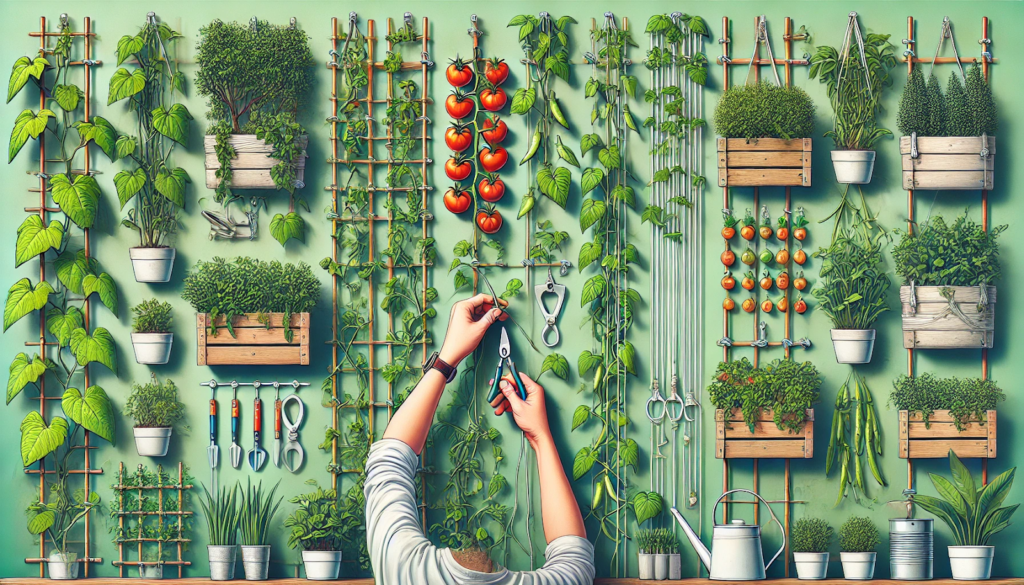Vertical gardening is a smart, space-saving method for growing more in less area. Training climbing plants not only adds visual appeal, but also improves air circulation, increases yields, and makes harvesting easier.
In this guide, you’ll learn how to properly train vines and climbing plants to grow upward in a healthy, manageable way.
1. Why Train Climbing Plants?
Climbers need guidance to grow vertically rather than sprawling on the ground.
Benefits of Training:
- Maximizes limited space (great for small gardens and balconies)
- Reduces disease risk by improving airflow
- Makes plants easier to maintain and harvest
- Keeps fruit cleaner and more accessible
- Creates shade and privacy screens if needed
Proper training keeps plants productive and beautiful.
2. Best Plants for Vertical Training
Vegetables:
- Tomatoes (indeterminate types)
- Pole beans
- Peas
- Cucumbers
- Squash (vining types)
Flowers:
- Morning glories
- Clematis
- Sweet peas
- Honeysuckle
- Bougainvillea
Fruits:
- Grapes
- Melons (with support)
- Passionfruit
These plants naturally seek vertical support and are easy to train.
3. Choose the Right Support Structure
Match the structure to the plant’s weight, growth pattern, and garden space.
Common Supports:
- Trellis – Perfect for peas, beans, cucumbers
- Tomato cages or stakes – Ideal for tomatoes and peppers
- A-frame or teepee trellises – Great for garden beds or containers
- Arches or pergolas – For large flowering vines
- String systems – Used in greenhouses and indoor gardens
Install supports early to avoid damaging roots or stems later.
4. How to Train Climbing Plants (Step-by-Step)
Step 1: Plant Near the Support
Place seedlings or seeds within 6–12 inches of the structure.
Step 2: Tie Plants Gently
Use soft garden ties, string, or plant clips to secure stems loosely.
- Do not tie tightly—leave space for stem growth
- Avoid wire or rough materials that may cut the plant
Step 3: Guide Growth
As the plant grows, wrap tendrils around the support or re-tie new stems upward.
- For tomatoes, use the “string and clip” method or spiral them up a single stake
- For beans or peas, let them self-wrap or guide the tips
Step 4: Prune and Maintain
Trim side shoots and damaged leaves regularly to prevent overcrowding and disease.
5. Tips for Vertical Garden Success
- Start early – Young plants train more easily
- Choose disease-resistant varieties – Especially in tight spaces
- Water at the base – Avoid wetting foliage
- Use mulch – Retains moisture and prevents weeds
- Harvest frequently – Encourages continued production
Check support structures weekly and adjust ties as needed.
6. Special Considerations for Heavy Fruits
If you’re training melons, squash, or cucumbers vertically:
- Use slings or nets to support fruit weight
- Harvest promptly to prevent snapping vines
- Choose compact or mini varieties for easier support
Vertical growth is possible for heavier plants with the right reinforcement.
7. Indoor Vertical Gardening
Climbing plants can also be trained indoors.
Try This:
- Attach hooks or trellis to a sunny wall
- Use shelves with hanging vines
- Combine with grow lights for year-round success
Great for herbs like basil and mint or decorative vines like pothos.
Conclusion: Reach New Heights in Your Garden
Training climbing plants opens up a whole new dimension of gardening. Whether you’re growing food or flowers, vertical supports help keep your garden organized, healthy, and full of life—especially in small or urban spaces.
Start with simple trellises and watch your plants climb their way to success.






